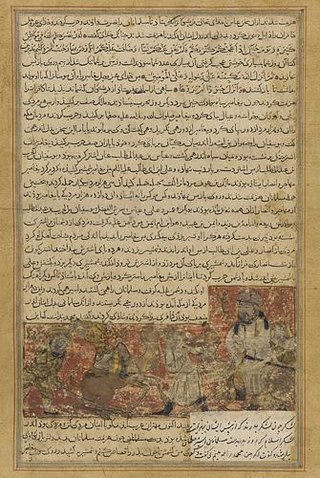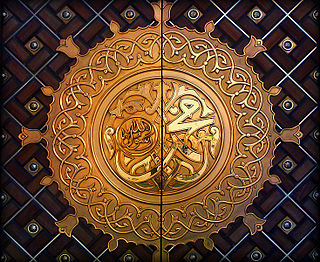
The Quraysh were a grouping of Arab clans that historically inhabited and controlled the city of Mecca and its Kaaba. The Islamic prophet Muhammad was born into the Hashim clan of the tribe. Despite this, many of the Quraysh staunchly opposed Muhammad, until converting to Islam en masse in c. 630 CE. Afterwards, leadership of the Muslim community traditionally passed to a member of the Quraysh, as was the case with the Rashidun, Umayyad, Abbasid, and purportedly the Fatimid caliphates.

The Treaty of Hudaybiyyah was an event that took place during the time of the Islamic prophet Muhammad. It was a pivotal treaty between Muhammad, representing the state of Medina, and the Qurayshi tribe of Mecca in January 628. It helped to decrease tension between the two cities, affirmed peace for a period of 10 years, and authorised Muhammad's followers to return the following year in a peaceful pilgrimage, later known as The First Pilgrimage.
The Banu Thaqif is an Arab tribe which inhabited, and still inhabits, the city of Ta'if and its environs, in modern Saudi Arabia, and played a prominent role in early Islamic history.

The military career of Muhammad, the Islamic prophet, encompasses several expeditions and battles throughout the Hejaz region in the western Arabian Peninsula which took place in the final ten years of his life, from 622 to 632. His primary campaign was against his own tribe in Mecca, the Quraysh. Muhammad proclaimed prophethood around 610 and later migrated to Medina after being persecuted by the Quraysh in 622. After several battles against the Quraysh, Muhammad conquered Mecca in 629, ending his campaign against the tribe.
This is a timeline of major events in the Muslim world from 601 AD to 700 AD.
Usāma ibn Zayd was an early Muslim and companion of the Islamic prophet Muhammad.
Ṣafwān ibn Umayya was a sahabi (companion) of the Islamic prophet Muhammad.

The Battle of Mu'tah took place in September 629, between the forces of Muhammad and the army of the Byzantine Empire and their Ghassanid vassals. It took place in the village of Mu'tah in Palaestina Salutaris at the east of the Jordan River and modern-day Karak.

The Conquest of Mecca was the capture of the town of Mecca by Muslims led by the Islamic prophet Muhammad in December 629 or January 630 AD (Julian), 10–20 Ramadan, 8 AH. The conquest marked the end of the wars between the followers of Muhammad and the Quraysh tribe.

The Battle of Hunayn was between the Muslims of Muhammad and the Bedouins of the Qays, including its clans of Hawazin and the Thaqif. The battle took place in 8 AH, at the Hunayn valley, on the route from Mecca to Taif. The battle ultimately ended in a decisive victory for the Muslims, who captured enormous spoils. It is mentioned in Surat at-Tawbah of the Quran, and is one of the few battles mentioned by name in the Qur’an.

Muḥammad bin ʿAbd Allāh bin ʿAbd al-Muṭṭalib bin Hāshim is believed to be the seal of the messengers and prophets of God in all the main branches of Islam. Muslims believe that the Quran, the central religious text of Islam, was revealed to Muhammad by God, and that Muhammad was sent to restore Islam, which they believe did not originate with Muhammad but is the true unaltered original monotheistic faith of Adam, Abraham, Moses, Jesus, and other prophets. The religious, social, and political tenets that Muhammad established with the Quran became the foundation of Islam and the Muslim world.

The Islamic prophet Muhammad came to the city of Medina following the migration of his followers in what is known as the Hijrah in 622. He had been invited to Medina by city leaders to adjudicate disputes between clans from which the city suffered. He left Medina to return to and conquer Mecca in December 629.
The Banu Sulaym is an Arab tribe that dominated part of the Hejaz in the pre-Islamic era. They maintained close ties with the Quraysh of Mecca and the inhabitants of Medina, and fought in a number of battles against the Islamic prophet Muhammad before ultimately converting to Islam before his death in 632. They took part in the Muslim conquest of Syria, and established themselves in the Jazira, while part of the tribe remained in the Hejaz. During the early Muslim period, the tribe produced notable generals such as Safwan ibn Mu'attal, Abu'l-A'war and Umayr ibn al-Hubab. Those who remained in Arabia were largely absorbed by the Banu Harb of Yemen beginning in the 9th century, while those in Syria and the Jazira were expelled to Upper Egypt by the Fatimid Caliphs in the late 10th century for supporting the Qarmatians. In the mid-11th century, a prolonged famine in Egypt prompted the tribe to migrate westward with the Banu Hilal into Libya. There, the Sulaym and its sub-tribes established themselves mainly in Cyrenaica, where until the present day, many of the Arab tribes of that region trace their descent to the Sulaym.

The Hawazin were an Arab tribe originally based in the western Najd and around Ta'if in the Hejaz. They formed part of the larger Qays tribal group. The Hawazin consisted of the subtribes of Banu Sa'd, and Banu Jusham, as well as the powerful Banu Thaqif and Banu Amir, which were both often counted separately from the Hawazin.
Khalid ibn al-Walid ibn al-Mughira al-Makhzumi was a 7th-century Arab military commander. He initially headed campaigns against Muhammad on behalf of the Quraysh. He later became a Muslim and spent the remainder of his career in service to Muhammad and the first two Rashidun caliphs: Abu Bakr and Umar. Khalid played the leading command roles in the Ridda Wars against rebel tribes in Arabia in 632–633, the initial campaigns in Sasanian Iraq in 633–634, and the conquest of Byzantine Syria in 634–638.
Sakhr ibn Harb ibn Umayya ibn Abd Shams, better known by his kunyaAbu Sufyan, was a prominent opponent turned companion of the Islamic prophet Muhammad. He was the father of Mu'awiya I and thus the forefather of all the Ummayid Caliphs. One of his daughters, Ramlah, was married to Muhammad, but this happened before Abu Sufyan's own conversion and without his consent.
Abu al-A'war Amr ibn Sufyan ibn Abd Shams al-Sulami, identified with the Abulathar or Aboubacharos of the Byzantine sources, was an Arab admiral and general, serving in the armies of the Rashidun caliphs Abu Bakr, Umar and Uthman rejecting the fourth Rashidun caliph Ali, instead serving Umayyad caliph Mu'awiyah.
Malik ibn Awf was a companion of Muhammad, and a leader of the Hawazin tribe of Ta'if. Before he converted to Islam, he was one of the commanders in the Battle of Hunayn against the Muslims along with the Thaqif tribe. He later converted to Islam before Muhammad's death.
The Muslim–Quraysh War was the six-year-long military and religious conflict in the Arabian Peninsula between the early Muslims led by Muhammad, and the Arab pagan Quraysh tribe. The conflict started in March 624 with the Battle of Badr, and concluded with the fall of the Quraysh tribe and the Conquest of Mecca.








